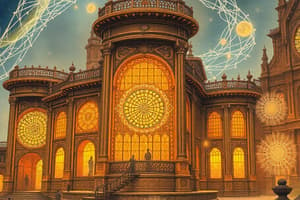Podcast
Questions and Answers
What can be inferred about the source of the content?
What can be inferred about the source of the content?
- It is exclusively for commercial purposes.
- It is a student-generated content.
- It is from an unknown blog site.
- It is from a reputable educational platform. (correct)
How does frequent repetition in the content impact its understanding?
How does frequent repetition in the content impact its understanding?
- It is only beneficial for visual learners.
- It makes the content more confusing.
- It leads to boredom for most learners.
- It helps to reinforce key concepts. (correct)
Which of the following could be a possible limitation of the provided content?
Which of the following could be a possible limitation of the provided content?
- It is heavily formatted for visual appeal.
- It lacks practical examples for application. (correct)
- It encourages interaction among students.
- It contains a variety of educational topics.
What is a likely reason for the repetitive structure in the material?
What is a likely reason for the repetitive structure in the material?
What approach might enhance engagement with the content?
What approach might enhance engagement with the content?
Which characteristic of the content suggests it is primarily intended for digital consumption?
Which characteristic of the content suggests it is primarily intended for digital consumption?
What is the likely consequence of not diversifying content presentation?
What is the likely consequence of not diversifying content presentation?
What kind of content structure can facilitate better learning experiences?
What kind of content structure can facilitate better learning experiences?
Flashcards
Database Management System (DBMS)
Database Management System (DBMS)
A type of software application that allows users to access and manipulate data over a network.
Database
Database
This refers to the organized collection of data, typically structured in tables, that is stored and managed by DBMS.
Relational Database Model
Relational Database Model
A database model where data is organized as a collection of tables with rows and columns, similar to a spreadsheet.
Image
Image
Signup and view all the flashcards
Data Integrity Constraints
Data Integrity Constraints
Signup and view all the flashcards
Data Querying
Data Querying
Signup and view all the flashcards
Data Processing
Data Processing
Signup and view all the flashcards
Database Security
Database Security
Signup and view all the flashcards
Study Notes
Work, Energy, and Power
- Work is done when a force causes a displacement
- Work = Force x displacement x cos(theta)
- theta is the angle between force and displacement
- Special cases:
- theta = 0°: Work = Force x displacement (force and displacement are in the same direction)
- theta = 90°: Work = 0 (force and displacement are perpendicular)
- Units of work: Joule (J) in SI, erg in CGS
- Power is the rate of doing work
- Power = Work / time
- Units of power: Watt (W) in SI
Different Types of Energy
- Mechanical energy:
- Potential energy (U): Energy due to position
- Gravitational potential energy (U = mgh) where m is mass, g is acceleration due to gravity and h is height
- Elastic potential energy(energy stored in stretched or compressed objects).
- Kinetic energy (K): Energy due to motion
- Translational, rotational and vibrational.
- Potential energy (U): Energy due to position
- Other forms of energy: Chemical, heat, electrical, nuclear, sound, light.
Principle of Conservation of Energy
- Energy cannot be created or destroyed, only transformed
- The total energy of a closed system remains constant.
- U + K = constant (for a freely falling body) where U is potential energy and K is kinetic energy
- In a pendulum, the total energy remains constant as potential and kinetic energy interconvert.
Studying That Suits You
Use AI to generate personalized quizzes and flashcards to suit your learning preferences.




